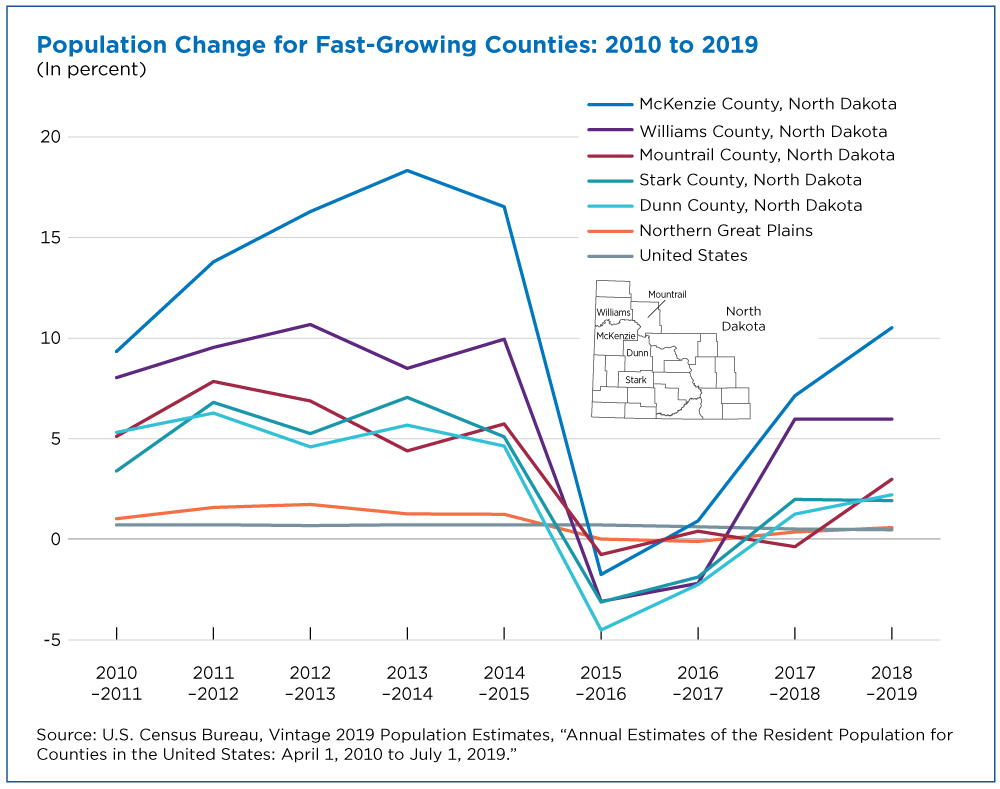North Dakota Oil Boom Drives Population Growth in Historically Declining Region
This story is part of an occasional series highlighting population and regional trends in the United States.
The population of the Northern Great Plains, a region that experienced declining populations for much of the 20th Century, surprisingly grew at a faster pace than that of the nation over the past decade.
The growth from 2010 to 2019 was primarily driven by 19 of the 106 counties that extend across parts of Montana, Nebraska, North Dakota, South Dakota, and Wyoming, hugging the border with Canada.
The five fastest-growing counties in the Northern Great Plains between 2010 and 2019 were also among the fastest-growing ones in the nation. All were in North Dakota, in areas that experienced an oil extraction boom.
The Northern Great Plains’ population was 1.1 million in 2019, up 8.3% since 2010, exceeding the 6.3% growth of the nation’s overall population during the same period.
But the region’s overall growth shows distinct patterns.
Uneven Population Growth
Nearly two-thirds (69) of the counties in the Northern Great Plains reported their highest decennial census populations between 1910 and 1930. The populations of another 18 counties peaked in censuses between 1940 and 2010. And a substantial share has had stable or declining populations for several decades.
The remaining 19 Northern Great Plains counties, mostly in metropolitan and micropolitan statistical areas, saw 2019 population estimates that surpassed their earlier census counts.
The overall growth rate of counties in metro areas was 10% between 2010 and 2019. The growth rate of the region’s counties within micro areas was 14.2%.
Fast-Growing Counties
The five fastest-growing counties in the Northern Great Plains between 2010 and 2019 were also among the fastest-growing ones in the nation. All were in North Dakota, in areas that experienced an oil extraction boom: McKenzie County, Williams County, Mountrail County, Stark County, and Dunn County.
McKenzie was the fastest-growing county in the nation during this period. All five of these counties experienced growth in the beginning of the decade, lost population in the middle of the decade, and then grew again.
Demographic Characteristics
Population growth patterns leave their mark in a region’s age and sex structure.
The Northern Great Plains had a higher proportion of population ages 55 and older and 14 and younger compared to the United States as a whole. The region had a lower proportion of population ages 15 to 54 with the exception of males between the ages of 35 and 39 — a potential result of the heightened demand for oil industry workers.
Industry and Occupation
Compared to the United States as a whole, the Northern Great Plains had a greater share of workers employed in the following industries:
- Agriculture, forestry, fishing and hunting, and mining.
- Construction.
- Transportation and warehousing, and utilities.
- Public administration.
Notably, the agriculture, forestry, fishing and hunting, and mining industry accounts for over 10% of workers in the Northern Great Plains but less than 5% of workers nationwide.
This region also had a higher percentage than the nation of people employed in natural resources, construction and maintenance jobs.
Hannah Rosenblum is a geographer in the U.S. Census Bureau’s Population Division.
Redistricting & Voting Rights Data Office (RDO)
Visualizations
2020 Census Demographic Data Map Viewer is a web map application that includes state-, county-, and census tract-level data from the 2020 Census.
Data
Fact Sheets
Blog Posts
Newsroom
Census Academy
View training resources for 2020 Census data.
Videos
Maps
-
2020 Census Demographic Data Map ViewerThe 2020 Census Demographic Data Map Viewer is web map application that includes state, county, and tract-level data from the 2020 Census.
-
2020 Census P.L. 94-171 Redistricting Data Map SuiteHere you will find the 2020 Census P.L. 94-171 Redistricting Data Map Suite
-
TIGER/Line ShapefilesView all the available mapping files from the Geography program.
Story Ideas and Statistics
Subscribe
Our email newsletter is sent out on the day we publish a story. Get an alert directly in your inbox to read, share and blog about our newest stories.
Contact our Public Information Office for media inquiries or interviews.
-
America Counts StoryFast Growth in the Desert Southwest ContinuesFebruary 11, 2019One of the most arid parts of the country has enjoyed population growth of more than 40 percent in three different decades since 1950.
-
America Counts Story94.7M Americans Live in Coastline RegionsJuly 15, 2019Coastline counties most vulnerable to hurricanes continue to grow. In the midst of the Atlantic hurricane season. See how many people live along the coasts.
-
America Counts StoryA Look at Businesses in Coastline Counties During Hurricane SeasonJuly 15, 2020Population growth in areas most vulnerable to hurricanes is of concern to emergency managers but so are the 2.4 million businesses in coastline areas.
-
Business and EconomyWhat Is the Nonemployer Marine Economy?April 09, 2025Thirty states had nonemployer businesses in marine economy sectors, including six states in the Midwest with receipts totaling nearly $11 billion in 2022.
-
Business and EconomyEconomic Census Geographic Area Statistics Data Now AvailableApril 07, 2025A new data visualization based on the 2022 Economic Census shows the changing business landscape of 19 economic sectors across the United States.
-
Income and PovertyWhat Sources of Income Do People Rely On?April 02, 2025A new interactive data tool shows income sources for hundreds of demographic and economic characteristic combinations.
-
Business and EconomyBig Improvements to the Annual Integrated Economic Survey (AIES)March 26, 2025The Census Bureau is making several changes and enhancements to capture 2024 economic data based on feedback from last year’s survey.












